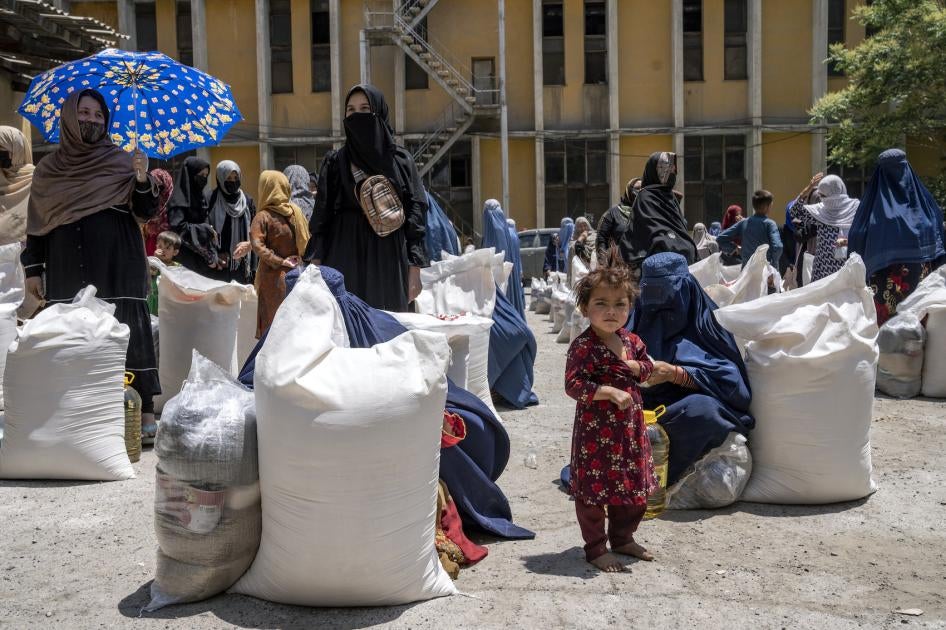Limiting support to Afghanistan to ever-dwindling levels of humanitarian aid to isolate the Taliban is not the answer.
Since the Taliban returned to power in 2021, Afghanistan has once again come under scrutiny for consistent allegations of human rights violations perpetrated mainly by the group.
At the same time, given that Afghanistan was completely dependent on foreign assistance before 2021, aid cutbacks, sanctions, and banking restrictions imposed by foreign governments – including the United States – have fuelled an economic and humanitarian crisis in the country since the Taliban’s return.
While donors should continue to press Taliban leaders to end their violations of the rights of women and girls, limiting support to Afghanistan to ever-dwindling levels of humanitarian aid to isolate them is not the answer.
The question as to how — or whether — governments should deal with the Taliban assumed greater importance after a UN meeting in Doha earlier this month between envoys from more than 20 countries. The meeting – the first with Taliban attendees – went ahead without women representatives from Afghanistan after the Taliban made clear its opposition to their participation and any discussion of women’s rights.
The gathering was meant to discuss Afghanistan’s financial and banking crisis along with drug trafficking and the impact of climate change — important issues that also disproportionately affect the lives of Afghan women.
Outrage by Afghan women’s rights groups led the UN to lamely hold separate talks with Afghan women and civil society representatives the day after the Doha discussions. But the question left hanging in the ether is how to address Afghanistan’s protracted economic crisis and worsening poverty without signalling support for the Taliban’s abusive policies.
Many countries and most multilateral institutions that have maintained a working relationship with the Taliban have limited their interactions to modest forms of technical support in the banking sector and essential services like internet and electricity, in addition to humanitarian aid.
In funding these services, donors are maintaining a distinction between isolating the Taliban authorities and trying not to cause further misery for Afghans, who face rising poverty, a crippled banking system, and the worsening floods-and-drought fallout of climate change.
Since well before 2021, countries including the US and UK also continued talks with the Taliban over counterterrorism and mutual concerns about ISIS-K, the Islamic State armed group that has carried out attacks abroad as well as targeting the Taliban and Shia Hazaras inside Afghanistan.
Ongoing engagement between the US and UK and the Taliban reflects their shared history. Afghanistan was almost completely dependent on foreign funding during the 20 years of war following the US-led invasion after 9/11. The suspension of most of those funds in August 2021 sent the Afghan economy into a freefall from which it is yet to recover.
Income-related poverty has worsened, and humanitarian aid that is insufficient to meet growing needs is no substitute for a functioning economy. In addition, while this aid has been a lifeline for Afghans facing widespread food insecurity and a broken public health system, it is shrinking, as donor countries tire of the Taliban’s intransigence and prefer to deal with other global crises.
There is no way to address Afghanistan’s acute problems while bypassing the Taliban altogether. But given that the Taliban have also interfered with humanitarian assistance by blocking women from jobs at UN agencies and international aid organisations except in healthcare, nutrition, and education, what can be done?
A humanitarian aid worker in Afghanistan told us that his Afghan female colleagues are able to work because his group prioritised principled engagement — insisting with the authorities on the need and right of women to work, to run businesses, and to receive aid equally.
Other humanitarian actors have been able to push back on interference because they had a long history of dealing with both the former government and the Taliban and, most importantly, because they had strong backing and funding from donor countries.
However, even if some women have returned to office jobs with aid groups, far fewer have been able to actually deliver aid in communities, and none have been able to take leadership positions in government; a contrast with the previous Afghan administration in which some women served as governors and ministers. In addition, their participation depends on time-consuming negotiations and local solutions that may not be replicated from one province to another.
But given that women and girls have suffered the most under the Taliban’s abusive policies – they have not only been restricted from education beyond the sixth grade and many work opportunities, but they are also among those hardest hit by the humanitarian crisis – such principled engagement is the only viable choice.
For the long term, even more important than humanitarian aid is assistance directed at durable solutions on a national scale – and not just on a project-to-project basis – in essential areas such as water management, irrigation, agriculture, climate adaptation, and public health. The World Bank’s Approach 3.0 also sets out a “principled approach” that supports bank-financed projects implemented by and for women, outside the control of the Taliban.
Such developments are crucial because women and women-headed households have higher rates of food insecurity, which contribute to increased chances of malnutrition-related disease, child labour, and early marriage. Water scarcity and Afghanistan’s increasingly intense cycles of droughts and floods also disproportionately harm women and girls.
There are no quick fixes for Afghanistan. But building resilience in these areas would also reduce Afghanistan’s dependence on humanitarian aid, while improving food security and access to essential public goods in the long run.


